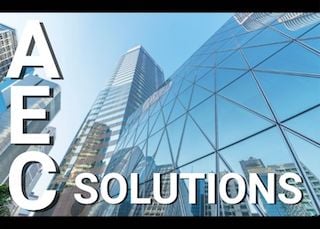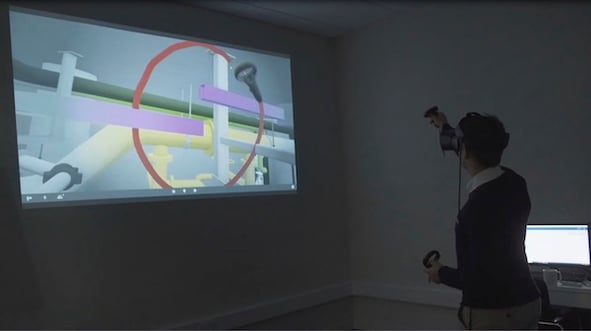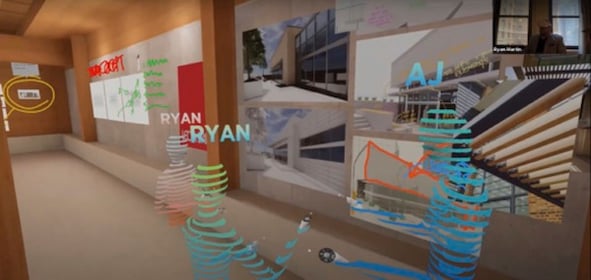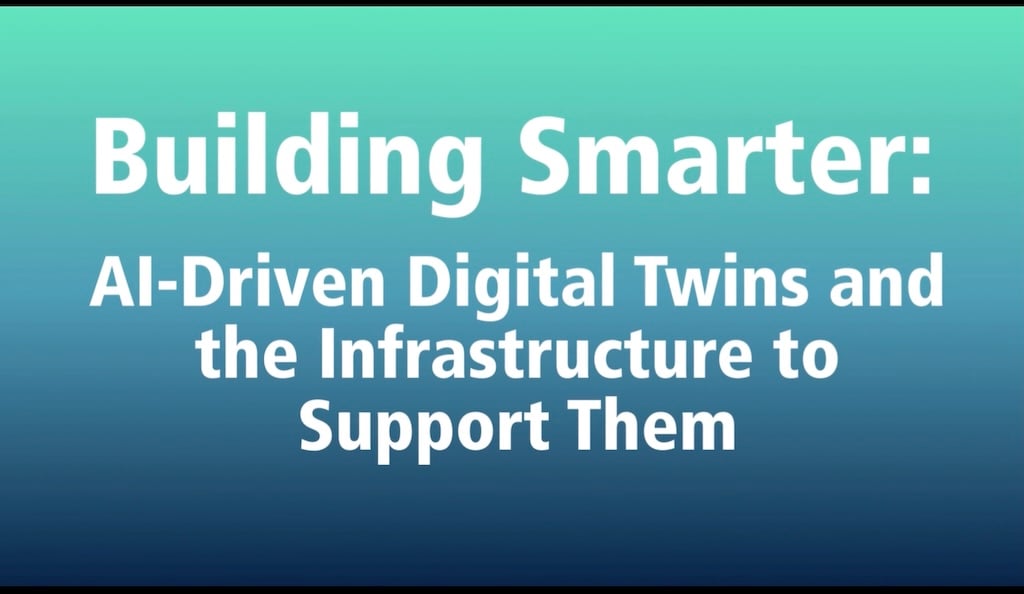
Virtual reality (VR) and other reality immersion tools are proving to be more than just novelty items on AEC projects, as design and construction firms find value in the developing technology. A growing number of building designers are using VR and related techniques to develop and refine their designs. Construction contractors are finding the technology increasingly helpful in planning and staging work. And, both designers and builders are using the tools to interact with owners and other project participants.
Early adopters encountered challenges implementing the technology, with large datasets clogging computer resources and bulky, tethered VR headsets limiting mobility. But as the technology has matured, VR systems have become easier to use and more palatable for companies debating investments in the technology.
While definitions vary in different camps, VR in the AEC world can be described as simulating reality with digital data in an immersive manner, such as with mobile devices, VR headsets, hand controllers, and other tools. Augmented reality (AR) augments digital data with physical data and images from cameras, laser scanners, and other sources, essentially bringing virtual objects to the real world. Extended reality (XR) is an umbrella term for a spectrum of immersive and interactive technologies that includes AR, VR, and mixed reality (MR), which is the continuum between the virtual and the physical worlds.
Digging Deep
Contractor Kane Group, with offices in Northern Ireland and the UK, encountered some of the early challenges of adopting VR and also experienced dramatic success on a complex project. When Kane was hired to install a myriad of mechanical, electrical, and plumbing (MEP) systems five floors below ground on a hotel expansion project, the firm recognized a need for an innovative approach. The Claridge's Hotel project in London was expanding downward, adding floors below ground instead of atop the historic building due to an existing roof-level MEP plant. Kane had to design, prefabricate, and install over 10,000 meters of pipework and numerous MEP components in a tight subsurface workspace with limited access.

The Claridge’s Hotel expansion in London required complex MEP systems to be installed five levels below ground. Image source: Kane Group.
“We realized that to do this project, we’d need to be at the top of the technological world,” said Gary Cowan, Kane’s head of digital construction. The team obtained a point cloud survey of the workspace, developed a 3D Revit model of the constructed basement, then exported the model to Navisworks for colorization prior to accessing the project via VR. The team used Prospect by IrisVR to develop and navigate a 1:1 representation of the design, said Cowan. “It allowed us to review models from the inside out, rather than using traditional methods of viewing things on a screen,” he noted.
Kane’s implementation of VR faced some challenges, first in convincing company management that the technology was worthwhile, and not just for games, said Cowan. After gaining management approval, the company purchased high-end PCs, VR headsets, and other equipment, then conducted intense training, involving a wide range of employees, some with limited computer experience. Kane built a dedicated VR room in the company’s London offices, as well as a second room at the Claridge’s project site.
Once up and running, the VR technology gained widespread acceptance among the project team, according to Cowan. Senior staff marveled at how they could interactively view a design and mark it up. Production staff from multiple locations found new ways to design collaboratively. “It shifted our entire workflow,” said Cowan.

The Kane Group used VR/XR technology to aid the design, fabrication, and installation of MEP systems in a tight workspace. Image source: Kane Group.
Based on the success of the Claridge’s project, completed in 2019, Kane has implemented VR as standard practice on all projects, according to Cowan. With the company focused on high-end housing work, the benefits quickly become clear to project participants, as issues such as piping conflicts and design errors are identified digitally before they reach the field. “It’s a totally different experience than looking at drawings,” noted Cowan. “You see the light bulbs coming on above people’s heads.”
Designers Get On Board
Building designers are also finding value in VR/XR technology, often in earlier stages of projects. At LEO A DALY, an American planning, architecture, engineering, and interior design firm, VR technology gained traction during the pandemic, when staff were working remotely and seeking ways to collaborate more readily.
“We started collaborating digitally,” said Ryan D. Martin, vice president and director of design for LEO A DALY. “Instead of pinning up work in our studio, we did it virtually.” Martin and his colleagues used The Wild platform to hold VR design charettes with clients and have “jam sessions. “Being able to grab everyone’s attention was a game changer,” he said.

Leo A Daly designers hold “jam sessions” in virtual reality to collaborate on designs. Image source: LEO A DALY.
LAD’s early experiences with VR were mixed, but the firm saw enough benefits to continue down the path. On the Hotel del Coronado project, in Coronado, CA, the firm used VR to design a series of renovations and new buildings across the property and share information with firm management and clients in an immersive manner. While the hardware was “a bit clunky,” early VR was effective in communicating designs, according to Martin. “We got people to see the project from the inside and outside, and show multiple iterations of designs.”
On a more recent Renaissance Hotel project in Washington, DC, the firm worked with contractor HITT to use VR for interactive design reviews before construction. The team developed a virtual model room where project stakeholders could see what guest rooms would look like after construction and provide feedback at key stages. Martin believes the process reduced post-construction comments by 10 – 15%, when compared with traditional design processes.
The use of VR can also save time, energy, and costs in multiple ways, added Martin. People can review designs from remote locations, reducing mistakes and rework. Travel costs can be reduced dramatically. An in-house study estimated that for an eight-month project, travel costs and lost productivity might exceed $100,000 without the use of VR.
Industry Adoption
The growth of VR/XR in the AEC arena is closely tied to ongoing quests for efficiency among designers and builders, according to technology developers. “We think the building industry has the best alignment of value to the effort that it takes to adopt XR,” said Gabe Paez, head of product for Autodesk’s XR offerings and former CEO of The Wild. He sees XR addressing some of the age-old issues with design reviews, collaboration, and communication that often challenge AEC professionals in the early stages of projects.
Autodesk’s presence in VR/XR was largely propelled by its acquisition of The Wild in 2022. The Wild previously acquired IrisVR in 2021. For the time being, The Wild and Prospect are being maintained as separate products, with The Wild more geared toward designers and Prospect more focused on workflow coordination.
As a specific example of XR application, Paez points to interior design of retail facilities. With traditional workflows often relying heavily on physical prototyping of spaces before construction, he sees significant opportunities for time and cost savings by performing design reviews with XR. “[Owners and AEC professionals] are looking for speed of iteration to evaluate ideas and test them,” he noted.
The energy sector also has high potential to reap benefits with expensive, complex projects, sometimes in dangerous work environments, according to Paez. Coordination of items such as piping and electrical work in congested locations can be difficult to conduct onsite, and XR can provide another approach. “You can have multiple people working together in a way that’s not even possible in the physical world,” he said.
While AEC has sometimes lagged behind manufacturing and other industries in adopting technologies such as XR, that may be changing, said Eric DeRosche, director of Autodesk’s infrastructure industry and business strategy. “If you look at the amount of research dollars and investment in technology dollars spent in the construction industry, it’s been a laggard,” he said. “But it’s catching up quickly. You’re now starting to see that transformation within AEC accelerate tremendously.”
The AEC digital transformation has already impacted workflows in ways such as moving paper-based plan development to more digital, 3D-model-based methods. If VR/XR continues to provide benefits to AEC firms, design and construction processes could morph even further in the years ahead. Instead of relying on paper or CAD drawings, project participants may increasingly don headsets and other equipment to experience and shape designs interactively.
Andrew G. Roe
Cadalyst contributing editor Andrew G. Roe is a registered civil engineer and president of AGR Associates. He is author of Using Visual Basic with AutoCAD, published by Autodesk Press. He can be reached at editors@cadalyst.com.
View All Articles




Searching for more information about Architecture, Infrastructure, and Construction?
Click here!